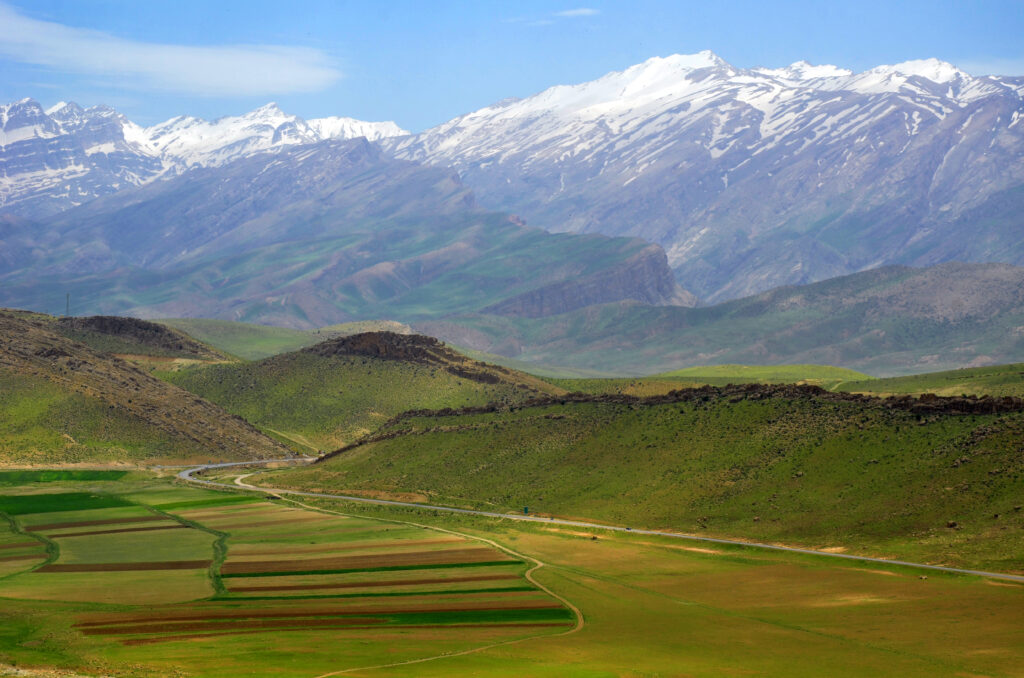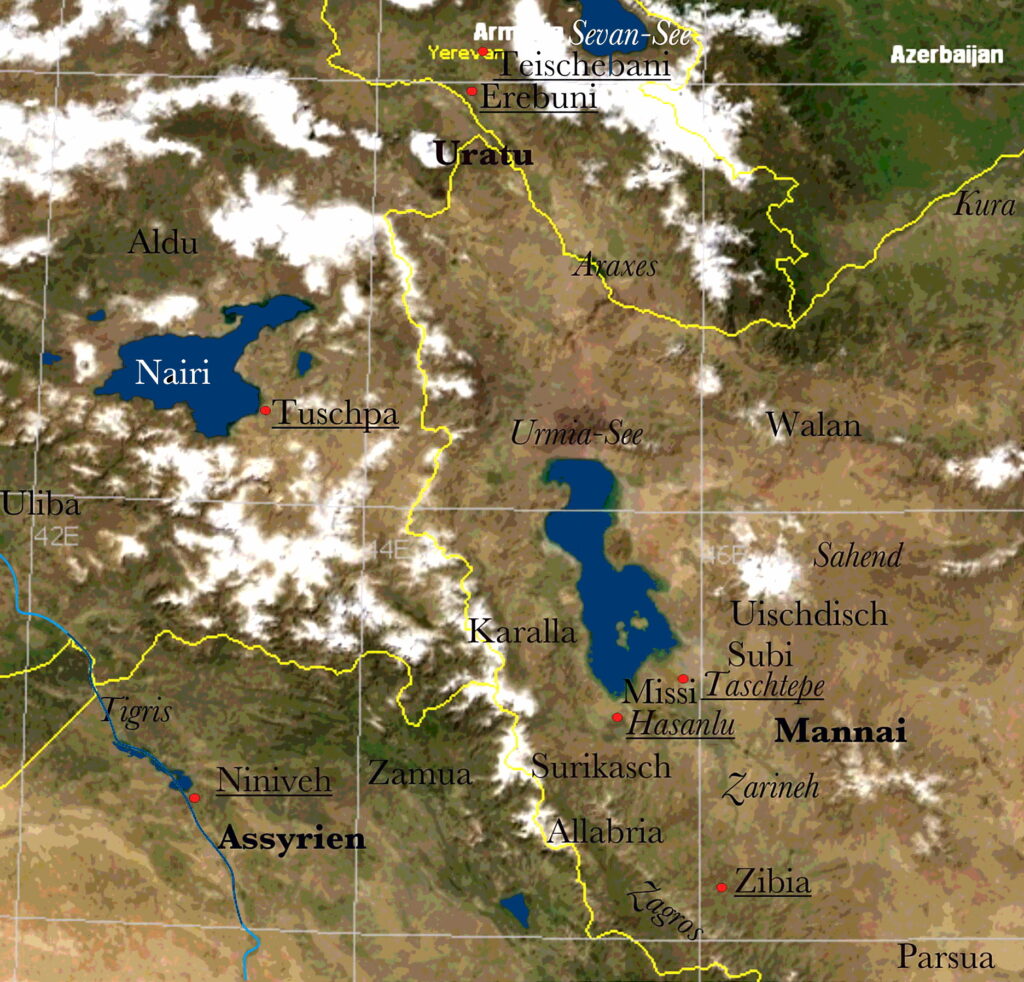
In western Iran, the Zagros Mountains stretch for about 1,500 km, forming a rugged barrier between the Mesopotamian Plain and the Iranian Highland. The landscape is harsh: steep ridges, narrow passes, deep valleys, and many peaks over 4,000 m. Seasonal snow and floodwaters further influence how people move and settle.
From early times, small and scattered communities lived here. Some farmed the valleys, others moved livestock between seasonal pastures. The terrain favored fortified settlements, and local chiefs who could gather armed followers or escape into the hills often held more practical power than distant kings. In this setting a ruler’s grip on power was never secure. Success depended on keeping subordinate chiefs loyal, controlling trade and movement routes, and managing the influence of stronger neighbours.
When empires such as Assyria and Urartu pressed into the region in the late 8th century BCE, smaller kingdoms faced a stark choice: resist (and risk destruction), or submit (and accept outside oversight). But submission did not always mean the end of authority. With the right strategy, it could help preserve it under imperial protection.
One of the most adept rulers in this context was Ullusunu of Mannaea. He shifted between Urartian and Assyrian support at key moments to secure and stabilize his rule. In doing so, he transformed the Zagros’ instability from a liability into an asset.
The strategic value of Mannaea
Mannaea controlled the fertile lands along the southern and eastern shores of Lake Urmia, giving its rulers direct command over both agricultural production and the breeding and supply of horses. Equally important, the kingdom lay along a major east–west corridor (often associated with the Great Khorasan Road), which linked Mesopotamia to the Iranian highlands and sustained long-distance trade.
Assyria had long sought dependable tribute and high-quality horses, and for this reason launched regular military campaigns eastwards to secure those assets. Around 744 BCE, under Tiglath-Pileser III, Assyria created new provinces (such as Parsua and Bit-Hamban), signaling a more permanent presence in the region.
For a Mannaean king, this was both danger and opportunity. Submission to Assyria risked over-dependence and external interference, but it also promised legitimacy, military backing, and protection from rival chiefs and foreign powers alike. Under Iranzu, Mannaea opted for cooperation: it paid tribute, and in return won Assyrian recognition as a loyal, though semi-independent, client kingdom.
At the same time, Assyria’s northern rival Urartu remained an active rival influence. Under kings such as Rusa I, Urartu solicited the loyalty of Zagros chiefs, especially when Assyria was busy elsewhere or seemed vulnerable. Many local rulers responded by shifting allegiance, soliciting support from both powers, or playing one off against the other to preserve as much autonomy as possible.

The benefits of Assyrian endorsement
Iranzu consolidated his authority by relying on Assyria’s formal recognition of his kingship. Being accepted as the legitimate ruler gave him the leverage he needed to suppress rebellious chiefs and position himself as the essential link between Assyria and the Zagros hill-communities. This sponsorship increased his prestige among the local elites, who might otherwise back rival contenders. Although Mannaea remained subordinate in tribute, military aid, and consultation, Iranzu’s rule was relatively stable and respected.
In 719 BCE, when the pro-Urartu chief Mettati of Zikirtu besieged two of his cities, Iranzu turned to Sargon II for help. Sargon responded quickly and reaffirmed Iranzu’s authority. This intervention confirmed Mannaea’s status as a loyal client state, while also boosting Iranzu’s practical power and legitimacy at home.
The coup by Ullusunu
When Iranzu died (ca. 716 BCE), his son Aza took the throne. But almost immediately, Aza was challenged by his brother, Ullusunu, who secured backing from chiefs with Urartian sympathies. In effect, Urartu was exploiting Mannaea’s internal divisions to extend its influence in the region. Aza was deposed and killed (thrown from Mount Uaush), after which Ullusunu declared himself king.
Sargon II responded swiftly and with force. He invaded Mannaea, captured the capital Izirtu, and confronted Ullusunu directly. However, rather than eliminating him, Sargon accepted Ullusunu’s submission. Assyrian sources describe Ullusunu as having “flown to the king like a bird” to beg for mercy. While this image serves Assyrian propaganda, it also conceals the political reasoning beneath the gesture: submission conferred legitimacy, legitimacy fostered stability, stability reduced rebellions, and a submissive but functioning king was more useful to Assyria than destroying the kingdom and rebuilding it from scratch.
In keeping Ullusunu on the throne as a loyal vassal, Sargon gained a dependable partner in the rugged Zagros frontier. Someone who could enforce order locally, collect tribute, and counter Urartian influence without requiring perpetual direct oversight. Ullusunu thus became not just a local ruler, but a strategic asset for Assyria.
Partnership in suppression
Once Ullusunu was reinstated, the arrangement between Mannaea and Assyria shifted toward active cooperation rather than a mere overlord-vassal hierarchy. Sargon II used his military force not only against Urartu directly, but also to suppress rebellious vassals of Ullusunu. Notable among those were figures such as Mettati, Dayukku, and Bagdattu, who had either refused to obey Ullusunu or had leaned toward Urartu’s cause. The suppression of such figures strengthened Ullusunu’s internal control, but at the same time reinforced Assyrian dominance.
In 714 BCE, Sargon mounted a major expedition against Urartu. Before launching into the heart of Urartian territory, he held a ceremonial feast with Ullusunu, placing him publicly on a throne set higher than that of his father. This symbolic act emphasised that Ullusunu’s kingship was endorsed by Assyria, but it also portrayed him as subordinate. The military campaign that followed significantly weakened Urartu’s power in the region and returned several strongholds to Mannaean or Assyrian control.
By 713 BCE, the arrangement was well established: Ullusunu remained king, paid tribute, and served Assyrian interests, Assyria secured its access to trade routes and buffer territories, and Urartu’s direct influence in Mannaea was curtailed.
Agency, dependency, and frontier politics
Ullusunu’s path demonstrates that local rulers could be far from passive under imperial pressure. He did not simply accept whatever fate came to him. He seized power with the help of Urartu, then recognised the benefits of submission to Assyria, and used Assyria’s military strength to maintain internal order. In turn, Assyria found it more practical to rely on Ullusunu than to impose full direct occupation, which in the rough terrain would be costly and unstable.
The relationship was not equal: Ullusunu was clearly subordinate. But it was also reciprocal: he offered value (control, tribute, stability) in exchange for endorsement and military backing. By turning submission into a tool of legitimacy, he preserved his rule and gave his kingdom a degree of continuity unlikely for many other small states in the region.
Conclusion
Ullusunu’s strategy in the Zagros shows how smaller powers navigated the pressures of larger empires. He relied on turning conflict into opportunity, and danger into leverage. His reign reveals that political agency in frontier zones was real: rulers could negotiate, switch alliances, and seek legitimacy. They were not always merely crushed or replaced.
Ullusunu should be viewed neither as a puppet nor as a helpless victim. He is best understood as a king-broker: someone who actively shaped his situation by exploiting imperial rivalries, but who also recognised and accepted the constraints of power.
Just passed the castle of Van the rulers of Urartu, so I like this article because of the trade route! Wil read it better when we are home!
It must be so great to see this all in person! I’m enjoying your travel pictures.